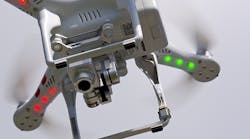Over the last several years, unmanned aerial vehicles (UAVs) have penetrated into every market level, ranging from the military and into the commercial and consumer sectors. The development of unmanned combat systems and consumer-grade models will ensure that the market continues its upward trajectory over the next decade, according to a recent report from the Teal Group, an aerospace and defense research firm.
The report estimates that UAV production will increase to $14 billion annually over the next 10 years, up from the $4 billion in revenues that the market earned last year. The result is that the market will earn total revenues of approximately $93 billion over the course of the next decade, according to the Teal Group report.
Philip Finnegan, the director of corporate analysis at the Teal Group, attributes this rapid growth to the sustained investment from the military, as well as the rapid development of the consumer market. In addition, these aerial robots are also being used increasingly in commercial and enterprise operations. In fact, the report notes that consumer and commercial markets have started to bleed into one another. “Consumer UAVs,” the report says, “are showing that they can do many of the easier commercial missions, such as simple real-estate photography.”
Many consumer manufacturers are trying to improve their position in the commercial UAV market, due to the potential for these systems in aerial surveillance and inspection, such as wildlife management, security, and infrastructure mapping. Parrot Drone, for instance, acquired a controlling stake in Airinov, a Paris-based company that develops UAVs for precision farming. The system employs remote and data-processing algorithms to gather information about crops.
On the other hand, some companies are developing UAV systems from the ground up to support commercial and industrial operations. San Francisco-based Skycatch, for instance, builds custom UAV systems for precision mapping and processing large data sets for industrial, mining, and construction sites. Its EVO3 system is fully autonomous, providing automatic takeoff and landing and wireless data transfer.
Despite the growing market for commercial and consumer drones, military spending will still account for the majority of the $14 billion in annual revenues. According to the Teal Group, military research, development, and production will account for 72% of the market over the next decade. Consumer and commercial UAVs, on the other hand, will account for 23% and 5% of the market, respectively. Although the commercial UAV market would appear to be relatively small, Finnegan says that this can be attributed to the small base from which it has grown.

